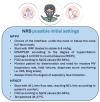An Updated Review on the Use of Noninvasive Respiratory Supports in the Management of Severe Asthma Exacerbations
- PMID: 40005443
- PMCID: PMC11857382
- DOI: 10.3390/medicina61020328
An Updated Review on the Use of Noninvasive Respiratory Supports in the Management of Severe Asthma Exacerbations
Abstract
Asthma is a reversible clinical condition characterized by airway obstruction due to bronchial smooth muscle contraction, inflammation and a hypersecretive state. Severe asthma exacerbations (SAE) may be a part of the natural history of this condition. Patients presenting with SAE are at higher risk of recurrent attacks, often nonresponsive to medical therapy and eventually requiring invasive mechanical ventilation (MV). The use of noninvasive respiratory supports (NRSs) may be beneficial in patients with SAE who are at risk of developing acute respiratory failure (ARF). However, their application is insufficiently supported by the evidence, as reports on their application in asthmatic patients are scarce and only a few retrospective studies with a limited number of participants have been published to date. This review discusses the potentialities of NRS in the treatment of SAE, with reference to the pathophysiological background and future perspectives on their use in asthma management.
Keywords: ARF; CPAP; HFNOT; NIV; NPPV; acute respiratory failure; asthma; high flow nasal cannula; mechanical ventilation; noninvasive intermittent positive pressure ventilation; noninvasive ventilation; status asthmaticus.
Conflict of interest statement
Luigi La Via declares an NDA with Flexicare and AiEndoscopic. Massimiliano Sorbello declares an NDA with Flexicare and AiEndoscopic. Cesare Gregoretti has received honoraria for lectures or consultancies from Vivisol, Philips, Mindray and Air Liquid (outside the submitted work) and declares a patent in association with the University of Palermo, Italy (No. 102019000020532, Italian Ministry of Economic Development). Giovanni Misseri declares a patent in association with the University of Palermo, Italy (No. 102019000020532, Italian Ministry of Economic Development). All the other authors declare no competing interests.
Figures
Similar articles
-
Noninvasive positive pressure ventilation in acute asthmatic attack.Eur Respir Rev. 2010 Mar;19(115):39-45. doi: 10.1183/09059180.00006109. Eur Respir Rev. 2010. PMID: 20956164 Free PMC article. Review.
-
Noninvasive Ventilation Use in Critically Ill Patients with Acute Asthma Exacerbations.Am J Respir Crit Care Med. 2020 Dec 1;202(11):1520-1530. doi: 10.1164/rccm.201910-2021OC. Am J Respir Crit Care Med. 2020. PMID: 32663410 Free PMC article.
-
Noninvasive ventilation in acute severe asthma: current evidence and future perspectives.Curr Opin Pulm Med. 2014 Jan;20(1):118-23. doi: 10.1097/MCP.0000000000000015. Curr Opin Pulm Med. 2014. PMID: 24285183 Review.
-
Noninvasive Respiratory Support for Pediatric Critical Asthma.Respir Care. 2025 Jun;70(6):760-776. doi: 10.4187/respcare.12487. Epub 2025 Jan 31. Respir Care. 2025. PMID: 39362757 Review.
-
High-flow nasal cannula and bilevel positive airway pressure for pediatric status asthmaticus: a single center, retrospective descriptive and comparative cohort study.J Asthma. 2022 Apr;59(4):757-764. doi: 10.1080/02770903.2021.1872085. Epub 2021 Jan 15. J Asthma. 2022. PMID: 33401990
References
-
- Global Initiative for Asthma—GINA 2024 GINA Main Report. [(accessed on 7 September 2024)]. Available online: https://ginasthma.org/2024-report/
-
- Vos T., Lim S.S., Abbafati C., Abbas K.M., Abbasi M., Abbasifard M., Abbasi-kangevari M., Abbastabar H., Abd-Allah F., Abdelalim A., et al. Global burden of 369 diseases and injuries in 204 countries and territories, 1990–2019: A systematic analysis for the Global Burden of Disease Study 2019. Lancet. 2020;396:1204–1222. doi: 10.1016/S0140-6736(20)30925-9. - DOI - PMC - PubMed
Publication types
MeSH terms
LinkOut - more resources
Full Text Sources
Medical


